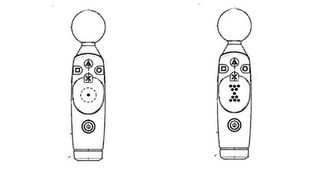Sony files patent for a (fairly cool) successor to the PS Move
Thanks to the digging of CVG News, a recently published patent filed by Sony has been uncovered. What’s the patent for? Why, a tentative new Move controller for the Playstation 4--which, in the patent, is referred to as a “flat joystick controller.” Considering the lackluster reception of the PS3’s peripheral, this is an intriguing move (pun not intended). While numbers are not forthcoming in terms of total sales for the Move, Eurogamer says that, as of November 2012, 70 million PS3 consoles and 15 million Moves had been sold. The fact that the PS3 Move wasn’t a forced bundle with the console, combined with its low selling numbers, gave developers no incentive to create content for the specialized controller. But could the Move do any better on PS4? Actually, yes, according to the finer details of the patent.
One of the main issues with the PS3 Move was that you had to have the PS Eye to use the controller. Otherwise, it was just a dead stick that looked like a lollipop. But if our reading of the nigh unintelligible patent drawl is correct, positional data will be tracked through mechanisms within the controller itself--specifically “the gyroscope, magnetometer, and accelerometer in the controller”, for those wondering. This data would then be transmitted and parsed by sensors already in the PS4.
The new controller has been freed from the Eye, but what else needs to be improved? For starters, this prototypic controller can be used for more than just motion. As with the DualShock 4, this controller will also have a touch interface. Unlike the PS4 controller, though, this touch interface is looking to be the main movement control. Why not a traditional joystick slapped on, like the Wii’s nunchuck? The answer is revealed in the patent.

First Sony disses the tradition joystick by saying it’s “hard to keep a user's thumb still while the user provides input,” because when the joystick moves, so too does the support for the thumb. There’s no stability, apparently. Their solution is the touch input surface. No wobbling on a stick anymore; with this controller, the “user's finger on the input surface causes friction that is recognized [as an input command].” Sound familiar? It’s the same spiel that Valve spun when talking about the touch interface for the controller of their Steam Box. Joysticks are dead! Touch controls are the way of the future!
We’ll wait to see how that pans out. And wait we will, since there are now two power players making moves away from the thumbstick standing in relief to the rest of the controller. And the touch surface won’t just be sitting there passively, either. Two phrases that were rampant throughout the patent: haptic feedback and LEDs.
In case you don’t know, haptic feedback utilizes the sense of touch to give feedback to the user. The steering wheel vibrating in those old arcade racing games is an example. But the tech world is alight with ideas for haptic feedback. So how will a touchscreen use haptic feedback? Check out this snazzy buzzword: Microfluids. “The microfluid technology may be used to physically change...the pattern on the input surface.” It’s like all those sci-fi movies where a metal surface warps and changes in response to someone’s touch. Imagine molding a touch surface to fit exactly the game you’re playing. Creating resistance when you’re putting in gold, or making a divot in the touch surface if you need to press a specific area over and over, or anything else you can think of. This is all speculation, but still... imagine the possibilities.

Then there’s the more easy-to-imagine LEDs behind the LCD display of the touchscreen. The Vita is a good example of how Sony has already integrated touch capabilities into a gorgeous display, so it’s not that big of a stretch.
Sign up to the GamesRadar+ Newsletter
Weekly digests, tales from the communities you love, and more
There were pages and pages more of speculative data to be ripped from that patent, but this new joystick still doesn’t address the main issue of the PS3 Move: no one was forced to buy it. When only ~20% of users even have the peripheral (which was the case with the PS3 Move), what developer will want to spend time and resources on content for this new controller? To make this controller truly effective, Sony would have had to do it day-one PS4 bundle ala Kinect 2.0. But that's a story for another day.
Zach was once an Associate Editor for Future, but has since moved into games development. He's worked at EA and Sledgehammer Games, but is now Narrative Director on League of Legends and Valorant at Riot Games.
Most Popular






